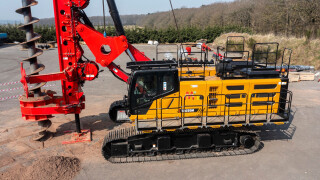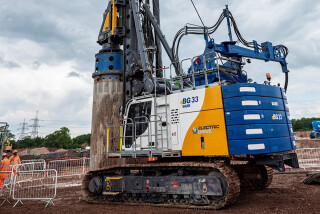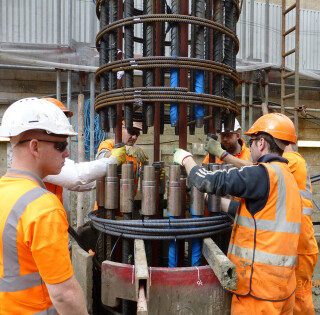Piling contractor Cementation Skanska is converting one of its Soilmec continuous flight auger (CFA) rigs to run on hydrogen fuel as part of a project funded by the government’s Red Diesel Replacement programme.
Cementation has teamed up with ULEMCo – a Liverpool-based specialist in hydrogen vehicle conversions – and scientists from the Building Research Establishment (BRE) to convert the 30-tonne Soilmec SR30 rig into a dual-fuel machine and evaluate the technology’s scope for carbon reduction.
The ‘Zero Carbon Hydrogen Construction Equipment for Real-world use’ project – Zecher for short – is being conducted at Cementation Skanska’s facility at Bentley Works in south Yorkshire. The SR30 is a medium-sized rig with a Cummins QSB6.7 engine that typically consumes 100 litres of diesel a day. This equates to carbon emissions of around 262kg, says Cementation.
The Zecher team will study the performance of the converted rig and use that data to explore the opportunities for using hydrogen to reduce carbon emissions and significantly improve air quality for a range of heavy-duty off-road machinery.
The project will examine the range of equipment used on construction sites, create detailed energy use and duty cycle data, and investigate the requirements and options for addressing the challenges of providing hydrogen on a practical scale for different machine types.
The Zecher team hopes that, given the high volumes involved, conversion to hydrogen dual-fuel will enable costs for green hydrogen to fall below those of white diesel, providing that the challenge of on-machine fuel storage is addressed.
“Zecher plans to show that conversion to dual-fuel will save up to 50% CO2 in this duty cycle and we expect that it will provide additional emissions benefits such as reduction in NOx and particulates,” said Amanda Lyne, managing director of ULEMCo.
Because machines such as piling rigs are owned and used for many years, finding a decarbonisation solution that uses these existing assets is not only cost-effective but also important for sustainability, explains Lyne.
Cementation managing director Terry Muckian says that replacing diesel is a key to achieving the company’s target of net zero carbon emissions by 2045: “We need solutions that will offer operational certainty and reliability, that will also set us on the pathway to full decarbonisation. We have already done this with HVO [hydro-treated vegetable oil] with all our plant fleet including piling rigs running on this fuel since the beginning of 2022.
“Exploring the role that hydrogen could play in our future operation is of strategic importance to us.”
Ranjit Bassi, senior consultant with BRE, said: “BRE’s role in the project is to look across the sector and to help accelerate the transition to clean fuels. Hydrogen looks to be one of the only currently viable routes to doing this in the available timescale.”
Sany enters UK piling rig market

Chinese machinery manufacturer Sany has launched its SR235 multi-purpose piling rig series onto the UK market.
Powered by a Stage V TAD 1181VE Volvo engine, the Sany machine offers various modes with rotary large-diameter piles, continuous flight auger, casing and low-headroom options.
Two models – the SR235M and SR285M – are currently available. They are the first in a series that will cover all aspects of augured, drilled and driven piling. The two models launched this year will soon be joined by a smaller and lighter model, the SR125, offering contractors an alternative for urban environments.
Sany’s factory in Beijing produces up to 3,000 rigs per year with more than 19 different models available. While they are sold in more than 50 countries worldwide, the UK market has so far proved itself generally resistant to Chinese-made machinery.
Paul McIntyre, business development manager for Sany Piling UK, said: “It’s an incredible time to enter the industry in the UK with high demand for both our core disciplines of rotary and CFA solutions. Large-scale projects such as HS2 and a buoyant piling industry with new projects finally getting out of the ground are helping to drive the demand.”
He added: “We have the support of the R&D team in Beijing 24/7 providing valuable, technical knowledge when needed and our rigs are backed by nationwide aftersales service and parts support to ensure a complete piling delivery solution in the unlikely event of any machine downtime.”
Plug-in piling rig proves its mettle on HS2
A plug-in electric piling rig from German manufacturer Bauer Maschinen has started work on an HS2 site in Warwickshire following successful site tests earlier this year.
The 100-tonne eBG 33 rig is being used by SB3, a joint venture between Bachy Soletanche and Balfour Beatty Ground Engineering, which is undertaking foundation work for Balfour Beatty Vinci Joint Venture (BBV) at the northern end of HS2 phase one in Warwickshire.
Bauer Technologies is itself working on HS2 in joint venture with Keller on a £95m geotechnical works contract for EKFB (Eiffage, Kier, Ferrovial Construction and BAM Nuttall) on the C23 section between the Chiltern Tunnels and Long Itchington Wood.
SB3 is using the plug-in drilling rig alongside a conventional diesel-powered rig to install large-diameter piles, with the aim of demonstrating that heavy, electric-powered construction plant can perform the same tasks as traditional diesel-powered machines.
According to SB3, the electric rig is already delivering an overall reduction in carbon emissions of 1,292kg CO2 per day compared to a traditional diesel-powered rig. The electric machine is also much quieter, reducing noise levels by 50%. But in terms of performance there is no difference and no power is sacrificed.
SB3 JV director Chris Merridew said: “Our team was eager to support Bauer as the first end-user of the electric rig and its new technology. It has the potential to be a massive game-changer for the industry and the wider construction sector in our continued drive to reduce carbon, noise and emissions.”
BBV innovation director Dan Fawcett said: “We’re so excited to trial the world’s first all-electric, high-capacity drilling rig at one of our HS2 sites in Warwickshire. This pioneering project marks a major step forward towards transitioning to all-electric powered plants, which is great news for the environment too.
“We’ll look to share what we learn from this trial and extend it across our other sites, as well as the wider industry.”

FPS updates concrete pump guide
The Federation of Piling Specialists (FPS) has updated its guidance on the safe use of concrete pumps to recognise industry changes over the past 10 years.
The guide, Pumping concrete to form piles, has been produced by a working group of five FPS members and a technical specialist from concrete pump operator Camfaud. The authors looked to simplify the document to better reflect how the piling industry has evolved since the 2013 original document and how safe working practice with pressurised concrete lines has changed.
The FPS guidance supplements the Construction Plant-hire Association’s more general Safe Use of Concrete Pumps guide (September 2013) to provides sector-specific guidance.
• The FPS document can be downloaded free of charge at tinyurl.com/2p9carry
Piling innovation rises to a technical challenge
Essex-based contractor Central Piling is using two continuous flight auger (CFA) piling rigs working in tandem to install deep foundations on a former quarry site in Kent.
The project is the latest phase of a major residential development comprising 849 new homes, a new primary school and a 12-acre ecology park.
Called, appropriately enough, The Quarry, the scheme occupies a disused 50-acre quarry in Erith that had lain untouched for more than 30 years.
Central Piling has been working on site since 2021, installing piles to support the new development. Due to the nature of the site, the ground conditions are highly variable, with large areas of mixed fill reaching depths of up to 30m in some places.
The challenge for Central Piling was to install piles that are deep enough to reach firm ground – and that means piles up to 40m deep.
“Rotary piling wasn’t feasible due to the depth of casing required and driven piling might not have penetrated harder elements within the fill,” says Central Piling managing director Steve Hadley.
Instead, the company chose to use CFA piling techniques. But that gave rise to another challenge: few CFA piling rigs can drill down beyond 30m. “There are rigs that can drill to about 36m but they are huge, 120-tonne machines,” explains Hadley.
Central Piling has overcome this problem by deploying two piling rigs, working in tandem. Both are Italian-made Soilmec machines: an SF50 CFA rig and its larger stablemate, the SF65 rig.
The larger of the two rigs is used to install the first stage of the pile to a depth of about 24m. It then decouples and backs away to allow the smaller SF50 to position itself over the first auger, to which it couples its own auger. This machine then continues the boring process to reach the required depth.
“This presented a safer and higher-production solution than adding single 6m sections of auger to a single rig,” says Hadley.
Central Piling had to develop a special tool to support the drilling equipment while the rigs were swapped over during the concreting stage of the operation. The team also configured the drum and pump set-up with a valve that allowed concrete to be shared between the two machines.
Hadley says that even if a 120-tonne rig had been available it would have proved unsuitable for this site. “It’s quite tight in some places but having two machines that can move independently means we can get into those spaces,” he says.
“I’ve never heard of anybody using two rigs in tandem like this – as far as I know, it’s a first,” he adds.
Piling in such ground inevitably means encountering unforeseen conditions. “We did encounter some locations of deeper fill as well as some voids,” says Hadley. “This necessitated close inspection of the arisings and a suitable adjustment to the design length [of the pile].”
When such conditions arose, Central Piling had to adapt its procedure – for example, by altering extraction rates to maintain concrete pressure, and pumping additional concrete to fill voids, to ensure successful results. In some places Central Piling had to re-drill in order to install viable piles – luckily, says Hadley, the client understood the variability inherent on this site and was accommodating to these changes.
Piling specialists to evaluate hazardous test method
The Federation of Piling Specialists (FPS) is analysing the viability of cross-hole sonic logging in the testing of large-diameter rotary bored piles.
Cross-hole sonic logging is an acoustic method for testing pile integrity that requires steel tubes to be fixed inside the pile’s steel reinforcing cage. This involves reaching inside the rebar cage as it is suspended within the bored hole. This is a dangerous procedure that has resulted in numerous injuries.
While the FPS has reviewed the use of sonic logging before, it is now investigating the technique further to assess its continued efficacy as a test method now that there are ‘safer’ alternative methods in wide use across the industry.
The review is being led by Jon Ball, chief geotechnical engineer at Roger Bullivant, part of the Vinci group. His team will investigate how many genuine defects are identified compared to innocent anomalies and their causes.
They will look at the sustainability cost of the method and any correlation between sonic logging results and results from alternative methods such as thermal integrity profiling (TIP) testing.
FPS chair John Chick said: “It is incumbent upon the FPS to investigate any methodology that presents a safety issue, and sonic logging has directly caused a number of injuries. Sonic logging must be scrutinised to understand if the benefits it offers are worth the risk given the number of alternative, safer and more sustainable testing methods now commonly available.
“Over the next few months, the FPS technical committee will fully investigate the technique and evaluate whether it is still a viable integrity testing method to be specified, with a view to publishing the results and any subsequent guidance by the end of 2022.”
Got a story? Email news@theconstructionindex.co.uk




